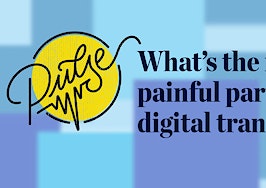From online showings to all-digital signings and closings, the digital transaction has fully come into its own. All month, Inman examines the companies and technologies driving this new world of digital transaction.
This article is the first part of a three-part series that takes a deep dive into digital transactions.
The onset of the COVID-19 pandemic brought the need for agents to virtualize nearly every aspect of how they help buyers and sellers. Suddenly, both as an industry and individually, everyone had to move quickly to adopt new tools and processes needed to ensure the safety of all involved. Of course, the pandemic only accelerated the move toward digital that was already well underway.
At times, the need to move quickly was more important than finding the right tool for the right job. The results, in terms of agent efficiency and consumer experience, often remain less than ideal to this day.
In this three-part series, we will look at the digital transaction from end to end — or cold to close — and examine new technologies that can enhance the process.
The search
When consumers lack existing relationships with trusted agents, they turn to search portals instead of agent websites with IDX feeds. Potential buyers scour the portals looking for the perfect home, while potential sellers ponder area estimates and evaluate agent reviews.
The flipside of consumer search, from an agent perspective, is the well-traveled road of “lead gen.” Internet leads have been a boon to some and a bane to others. When consumers press the button, they expect the same sort of near-immediate response they enjoy from other online experiences.
As iBuyers and tech-forward teams with inside sales agents have grown in marketplace standing, consumers are noticing when they get an immediate digital response — and when they don’t. Unfortunately, lack of systematic response to inquiries frequently leads to the first detour or dead end on the road to the fully digital transaction.
Whether leads come from referrals, agent websites, Facebook ads or industry search portals, consumers expect a quick and meaningful response. For agents, technology and process are the answer. The following are three solutions that keep digital inquiries on the digital path:
1. Lead response
Responsiveness to inbound leads needs to improve. David Anderson, CEO of LionDesk, summed it up well when he recently said, “With today’s affordable CRM technology, there is no excuse for not responding to new inquiries in minutes — versus hours or even days.”
“Prospective clients expect immediate response — or they are quickly on to the next agent,” he continued. “To automate and scale lead response, agents are turning to CRM systems with follow-up task reminders and AI-powered lead assistants that automatically engage buyers in text message conversations. All of this automation is easy-to-implement and results in superb client experiences.”
By implementing CRM campaigns, the burden of follow-up can largely be offloaded to the system. With a highly integrated CRM at the center, there is almost no limit to the number of lead sources that can be plugged in to scale lead gen efforts.
2. Video messaging
There are many uses and benefits of video messaging in the digital transaction process. As Ruben Dua, CEO of Dubb.com said, “Today’s demands of social distancing and busy schedules have real estate professionals turning to video messaging to build rapport, establish trust, and show homes. Whether it is for lead follow-up, a virtual showing, or contract signing, our data shows us that video messaging can increase engagement rates by over 200 percent.”
While video messaging apps like Dubb are easy to use for lead response and showings, a primary benefit is that they allow for asynchronous conversations. Getting buyers and sellers on the phone can be challenging. By communicating via video messaging from your laptop or mobile device, your clients get to see and hear you — at their convenience — without having to align schedules.
An additional, often-overlooked benefit of dedicated video messaging apps is the ability to avoid getting “frozen” on Zoom or FaceTime when connections are less than perfect.
3. Co-browsing
Another way to improve the digital experience for clients and agents alike is through the use of emerging co-browsing technologies. With modern co-browsing solutions like Samesurf, remote clients and agents can now easily share their online homebuying journeys, all without ever having to download an app or leaving their browsers.
These journeys originate on discovery sites like consumer MLS portals and can take advantage of more immersive experiences like 3D virtual tours that often appear choppy on traditional screen-share and videoconferencing apps.
David Pirnazar, CEO at Samesurf, stated that its install and code-free technology is seeing mass adoption in the real estate industry. Since co-browsing is the most instant, interactive and secure way to seamlessly simulate the experience of being together in real life, it has seen a surge in popularity during the pandemic.
In comparison to screen-sharing apps that constitute a one-way experience that’s typically led by the agent, co-browsing enables the client to be in control of the search process while the agent looks on remotely. This paradigm shift has proven highly effective in fostering an increased level of client trust, bolstered by the ability to have all decision-makers join the shared experience within seconds — regardless of location.
The wrap-up
Although these are busy times, it is crucial that agents continue to improve the consumer experience by evaluating possible improvements to the agent “tech stack.” With that, consider these following takeaways:
- CRM systems: Determine if your CRM system can integrate and automate the “top of the funnel” lead-gen sources. To provide an immediate and digital response, your CRM should have campaigns that automate and orchestrate multichannel follow-up and ideally, include AI-powered responses. Ensure that your CRM system has a large number of native integrations and, hopefully, connectivity to even more website and lead generation systems through a system like Zapier.
- Video messaging: Explore video messaging apps that allow you to create rich, personalized video messages that can even include walkthroughs or videos of key areas of interest in selected properties — all able to be delivered asynchronously, so you don’t have to coordinate schedules with clients.
- Co-browsing: Evaluate co-browsing as a cutting-edge way to build rapport through a better digital search experience with potential buyers.
Stay tuned for the second part of this series on showings, which will focus on the all-digital tools that will make your remote showings a breeze instead of a “can you hear me now” moment.
Marvin Stone serves as senior vice president, business integration for Stewart Title Guaranty Company. Connect with him on Twitter.













